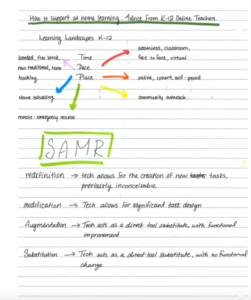How would you describe the historical and theoretical trends in k-12 online and distributed learning? What did you already know, what do you know now based on the course readings and activities, what do you hope to learn?
Before this topic, I was unaware of how far back the use of online and distributed learning went especially in Canada. It was interesting to read about the inner workings of distributed and online learning in Canada and how it varies across the country as well as how learning theories and the definitions of open, distributed, online, and e-learning have developed, grown and changed over the years.
Learning Theories:
Behaviorism:
Behaviorists believe that “it is possible to reinforce through reward or punishment the association between any particular stimulus or event and a particular behavioral response (Bates, 2014).” Behaviorism promotes the use of reward and punishment to encourage students to reach the outcome desired and encourages the use of determining student learning and growth through “pre-defined and measurable outcomes (Bates, 2014)”.
Cognitivism:
Cognitivists believe that “if we are to understand learning we cannot confine ourselves to measurable behavior, but must also concern ourselves with the learner’s ability mentally to reorganize his psychological field… in response tp experience (Bates, 2014).” In other words, the learning occurs through the student’s personal interpretation of the knowledge as they engage in real-world experiences. “Cognitive psychology is concerned with identifying and describing mental processes that affect learning, thinking and behavior, and the conditions that influence those mental processes (Bates, 2014).” Most importantly, cognitivism focuses on teaching students how to learn.
Cognitivists also link mind to computer as basic mental processes is considered to be “hard-wired (Bates, 2014)” which can be affected by external factors. This idea has led to growth in technological education. This includes intelligent tutoring systems, artificial intelligence, pre-determined learning outcomes, and instructional design approaches.
Constructivism:
Constructivism focuses on the personal aspects of a learner’s education including social interaction and free will. It is argued that “individuals consciously strive for meaning to make sense of their environment in terms of past experience and their present state (Bates, 2014)”.
Most importantly it is stated that learning must be a social experience to gain the most positive outcome. interaction between the student, their instructors, and their classmates is essential to optimum learning.
This links back to the importance of social communication for optimal learning suggested by Garrett Dikkers (2018) and Roberts et Al. (2018),
Connectivism:
Connectivism focuses on learner autonomy, openness, diversity in content, and interactivity and is more geared towards the role of the individual learner. This learning theory is more acceptable for an informal learning environment (Bates, 2014).
Definitions
Open Education Practices:
Practices which “support the productions, and reuse of high quality open educational resources (OER) through institutional policies, which promote innovative pedagogical models, and respect and empower learners as coproducers on their lifelong learning path (Roberts et Al., p. 528)”.
- Originally named open learning
- initially introduced to remove the barriers of a closed environment and open up learning
- Now includes Open Software, data, and learning.
- Supported by:
- Dewey (1916) – learning from and with each other
- Vygotsky (1978) – learning is shaped by sociocultural factors
- Paquette (2005) – based on individual differences, growth, teacher acts as an indirect influence, developmentally appropriate learning outcomes (Roberts et Al., 2018).
Open Learning:
- 8 principles
- learner-centeredness
- lifelong learning
- flexibility in learning
- removal of barriers to access
- recognition of prior learning experiences and current competencies
- learner support
- expectations of success
- cost effectiveness (Roberts et Al., 2018, p.529)
Blended Learning:
- Part through online learning, some element of student control over time, place, path, and/or pace
- Part in traditional school setting
- Modalities in each learning journey within subjects are connected to provide an integrated learning experiences (Roberts et Al., 2018, p.539).
E-Learning/Online Learning
- “The implementation of computer technologies to education. E-learning can take many forms, whether it is used face to face in classrooms, as a share of required classroom activities or stroke work (e.g. online discussions), or to deliver a fully online course. E-learning can include distance education as well as traditional in-class instruction (Barbour and LaBonte, 2018, p. 601) “
Canada
- Education varies across the country, ministries develop curriculum to respect the uniqueness of each province
- Distance Education used for almost 100 years
- B.C. began using distance ed. in 1919 and began virtual schools in 1993
- Online and blended programs vary from traditional distance education models, to all online or a blended model
- One of the highest per capita student enrollment in e-learning programs
- one of the first countries to use the internet to deliver distance eduction
- Most programs in Canada use a blended learning format, asynchronous online format, or video conferencing (Barbour and LaBonte, 2018).
British Columbia:
- 59 district distributed learning schools
- 16 private distributed learning schools
- The ministry of Education manages a list of all courses offered by distributed learning schools and provides content and online hosting services (Barbour and LaBonte, 2018).
Moving on:
I am interested to look further into the affect of social interaction on student growth, development, and learning. How can we promote this with younger students?
How can we promote the use of blended learning system with younger students and those with exceptionalities?
How can we encourage collaboration through online medium with our exceptional students and our primary students?
To what scale do each of the learning theories fit with distributed and open learning> What about multimedia learning theories?
References:
Roberts, V. , Blomgren, C. Ishmael, K. & Graham, L. (2018) Open Educational Practices in K-12 Online and Blended Learning Environments. In R. Ferdig & K. Kennedy (Eds.), Handbook of research on K-12 online and blended learning (pp. 527–544). Pittsburgh, PA: Carnegie Mellon University ETC Press.
Barbour, M & Labonte, R. (2018) An Overview of eLearning Organizations and Practices in Canada. In R. Ferdig & K. Kennedy (Eds.), Handbook of research on K-12 online and blended learning (pp. 600-616). Pittsburgh, PA: Carnegie Mellon University ETC Press.
Bates, T.(2014). Learning Theories and Online Learning. [Blog post]. Retrieved from https://www.tonybates.ca/2014/07/29/learning-theories -and-online-learning/.


Leave a Reply
You must be logged in to post a comment.